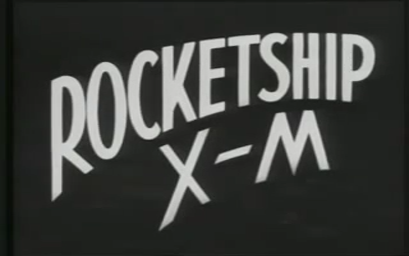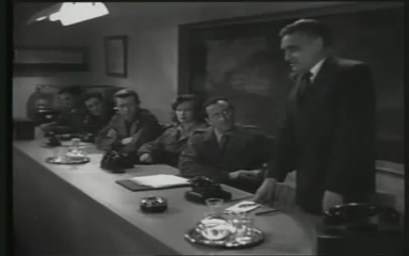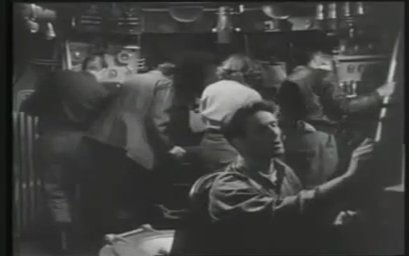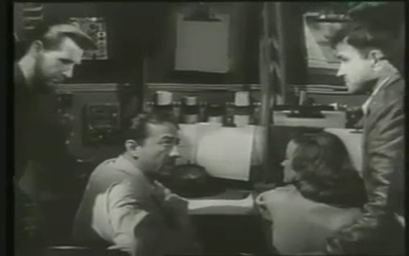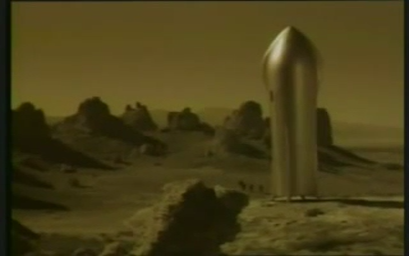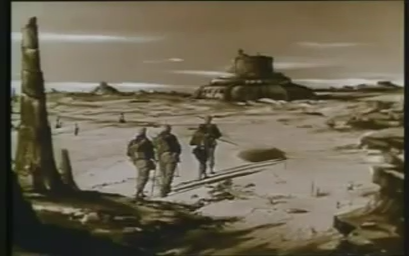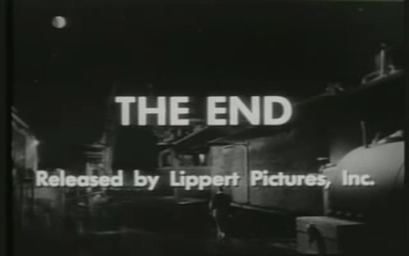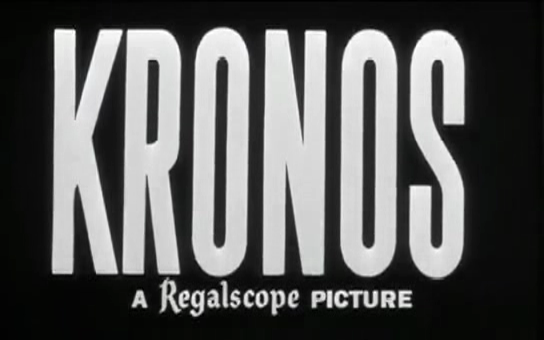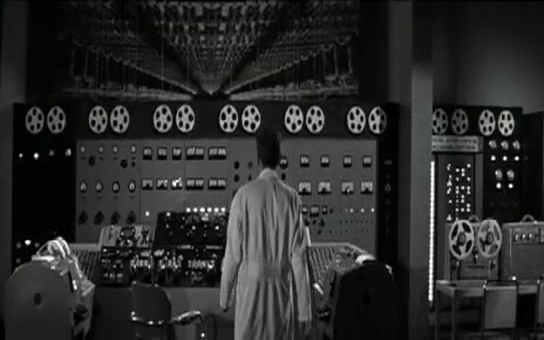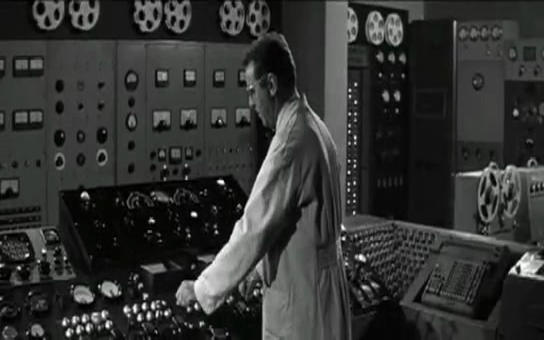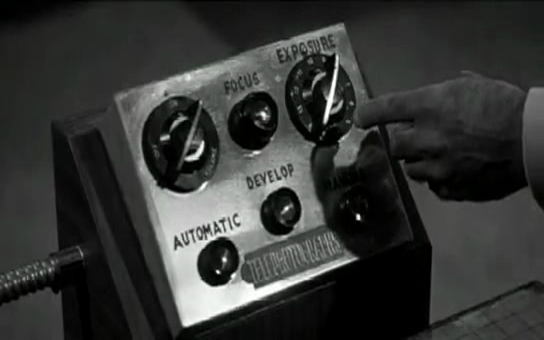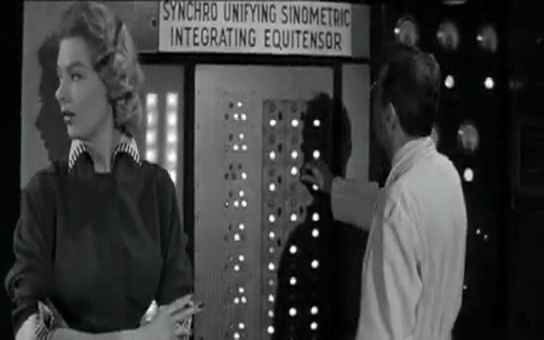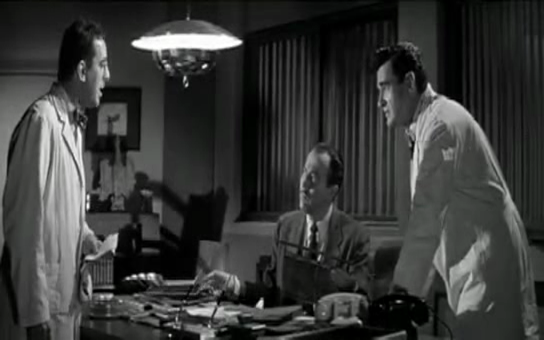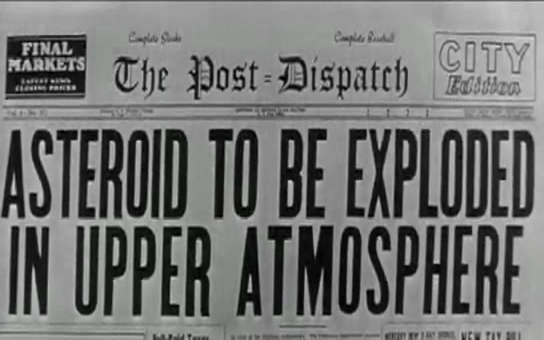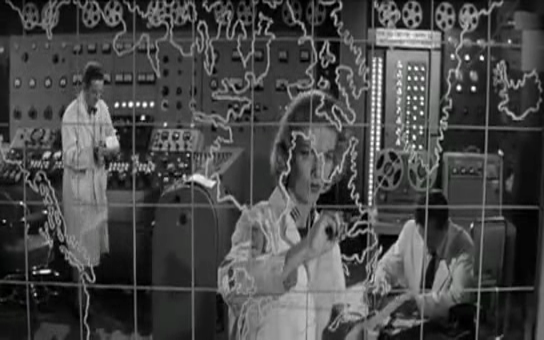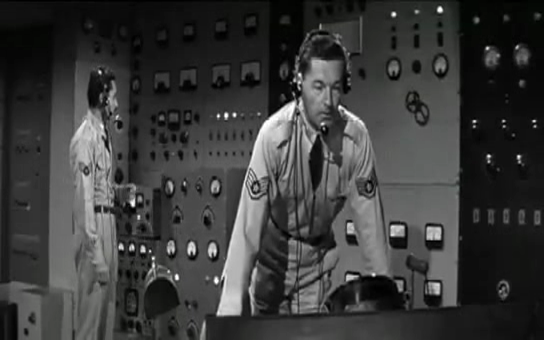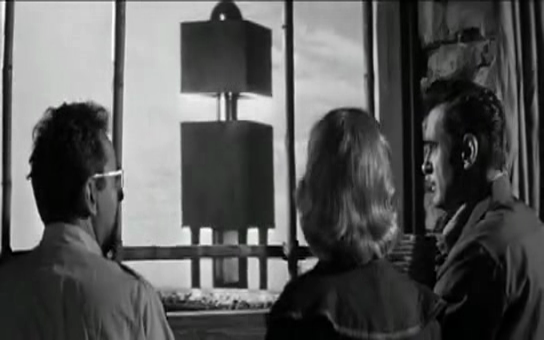-
#25 – Rocketship X-M (1950)
Rocketship X-M (1950)
Film review #25
Director: Kurt Neumann
The first science-fiction movie post-WWII to be set in outer space…did it live up to the hype?
At a government facility, members of the media have assembled at a press conference. There, Dr. Fleming announces that within the next 20 minutes, they will launch the first manned spaceship, Rocketship X-M (Xpedition-Moon) into outer space and to the moon. He then introduces the five crewmembers who will be on board: Col. Graham, the pilot. Dr. Lisa Van Horn, chemist. Dr. Karl Eckstrom, the ship’s designer. Major William Corrigan, the navigator and Harry Chamberlain, engineer. The five of them answer questions put to them by the press before making their way to the rocketship…
Everything is going smoothly with the journey until the ship mysteriously loses it’s velocity and stops in space. Graham and Van Horn re-calculate the equations for the ships fuel balance, and when they finally finish, they adjust the fuel composition and the ship regains velocity. This success is short-lived however, as the ship goes much faster than anticipated, and the crew is knocked unconscious as the ship speeds off into space…
As the crew awakens, they find they have drifted way off course, and when they look out the window, they realise how far: They see the planet Mars. They surmise they are being pulled there by some mysterious force, and they decide to let “a force greater than themselves” pull them to the surface. When they land, some of the crew have reservations about venturing out, but they eventually agree that the scientific value of the exploration is too great to pass up, and the five of them set out to explore the surface. Mars is a barren planet, but eventually they find evidence of an advanced civilisation in buildings and metal statues. Wondering what could have happened, they then detect a large amount of radiation and it all becomes clear: Nuclear war had reduced an atomic age to ruin, a lesson that the crew thinks should serve as an important message and warning to the people of Earth.
The crew rests in a cave during the night, and while the rest sleep, Harry notices creatures in the distance. He wakes everyone up and they go and investigate. They find footprints, and Eckstrom and Harry go and investigate. Eventually, they find a gang of primitive men. What has happened on this planet is now clear: An atomic age has become a stone age, caused by nuclear war. The cavemen become violent, and start to attack the crew by throwing rocks at them. They kill Harry, and Dr. Eckstrom runs back to the other three and tells them to run to the ship. Under the constant rock throwing, Eckstrom is then killed, and Corrigan is seriously wounded, so Lisa and Graham carry him back to the ship.
Making it’s way back to Earth, Lisa and Graham are reflecting on their journey. Approaching Earth, they realise that don’t have enough fuel to land, and in an attempt to ensure their whole journey wasn’t in vain, they attempt one last contact with Earth. Dr. Fleming, who has been waiting for news of the ship since it lost contact with Earth. They transmit the correct fuel equation they made, and warned him of the dangers of Mars, and the horrible consequence of nuclear weapons. After the radio falls silent, Lisa and Graham hold each other as the ship enters the atmosphere and crashes into a mountain range in Nova Scotia…
In Fleming’s office, members of the press enter, eager to know the fate of the rocketship. Fleming confirms that the ship that crashed near Nova Scotia is the X-M. When the journalists ask him if the mission was a failure, he says that the mission proved so much about space travel and exploration, and a strong message about the fate of mankind and the use of nuclear weapons could save humankind entirely. He then remarks that “Tomorrow will see the construction of X-M2”, and that this is only the beginning, resolute that the sacrifice of the X-M crew was not in vain…
While this is technically the first movie to be released post-WWII about space travel, it did cheat a little. Essentially, the first movie was supposed to be Destination Moon, but when that film got delayed, Rocketship X-M was quickly shot in 18 days and rushed into cinemas, hoping to capitalise on the hype surrounding Destination Moon and steal a bit of it’s thunder.
Being shot in eighteen days, you can’t really expect a very high production value from this film, and it shows. Most of the film is set in the rocketship, so no need to build lavish sets, and the uniforms are seemingly leftover military attire (Wearing a tie in space? Sure why not…). It should also be noted that a lot of the on-location scenes on the surface of Mars and shots of the rocket were not in the theatrical release, and instead stock footage of the V-2 rocket was used, again primarily due to the the film being quickly rushed out to beat Destination Moon into cinemas. These extra scenes were shot about twenty years later, carefully recreating the costumes from the movies and an accurate rocketship model by film enthusiast Wade Williams.
This film is very easygoing. There is no massive conflict, or no adrenaline-fuelled action sequences, the narrative of the movie is an account of the space travel itself, and what would happen during transit. For a movie that focuses such much on the details of space travel, there are a lot of scientific inaccuracies present in the film. For example, the inconsistency of representing gravity and weightlessness: Though they encounter occasionally the phenomenon of weightlessness in that random objects start floating, the ship is always seen like a cockpit of an airplane, with the crews feet firmly on the ground. The sound of the fuel tank being jettisoned, and when the rocket passes through a meteor shower, these scenes are accompanied by a sound, which of course would be impossible in the vaccuum of space. Also, it is mentioned that the ship has “twice the amount of fuel needed” to complete the voyage. This would be impractical for actual flights, but it does support the narrative, and allows the rocket to return to Earth after it’s lengthy detour to Mars.
The way in which Mars itself is depicted is also aloft with inaccuracies. The rocky, and barren nature of the planet is rather accurate, but the crew walk around the planet with just oxygen masks on. This would be impossible on the actual Mars due to the difference in pressure, so one would need at least some eye protection, and the cooler temperatures would mean some form of insulating clothing would need to be worn. Most of these inaccuracies we can overlook, since this movie was made seven years before the first man-made satellite was launched into space (Sputnik-1), and eleven years before the first human (Yuri Gagarin). So with very little to go on, the movie explores the different effects and experiences of space travel, and conveys them to an audience, they lack the scientific accuracy we come to expect from spaceflight, but one one has to remember the historical context in which this movie was made, and overlook certain portrayals of weightlessness and such forth. Of course, the rushed nature of the film certainly doesn’t help.
regarding the historical context of the film, casually calling a press conference some twenty minutes before the launch of the rocket shows a somewhat naiveity in how space travel works. Some of the attitudes towards the only female crewmember, Lisa Van Horn highlight the sexist attitudes of the 1950’s too. however, I found it rather difficult to tell if it was addressing the issue, such as when Dr. Eckstrom tells journalists she was selected for her expertise, and not because she was a woman, and other scenes when she asks whether one of the crew believes she should stay home and bake all day, he replies “isn’t that enough?” I think the dialogue really walks the line between being controversial, addressive and offensive from today’s perspective, though back then it probably would not have been labelled as such.
The ending is where the whole movie takes a dramatic twist. For a movie that is mostly casual and uneventful for the first hour, the last fifteen or so minutes sees the rocketship crash, and all five crewmembers die, far from the happy endings one usually sees in movies from this era. After this tragedy though, the ending is one not of just tragedy, but also of hope. Through the crew bravery and curiousity, they have successfully flown in space, landed on a hostile planet, and warned Earth of the dangers of nuclear weapons. The scientific curiosity is here glorified, and there sacrifice is far from in vain. While the scientist was being traditionally portrayed as the sidekick or out of the main spotlight in American cinema, this ending is quite powerful and challenging in comparison to other films of the day.
Overall, I’d say Rocketship X-M is very much a film of it’s day: Back when one could shoot a film in eighteen days and get away with it. The film shows the visions and possibilities of space travel, at a time when such things were only pipe dreams. It also serves as a warning about the dangers of nuclear weapons, and the power they possess to throw civilisation back to the stone age. While probably not a film you might casually watch nowadays, it reveals a lot about the time and place it was set, which I think makes it a rather significant film culturally. Although the film is unmistakeably a 1950’s film, the ending takes a bold step in almost martyring the scientist, both curious and adventurous, working towards the protection of mankind…
-
#10 – Kronos (1957)
Kronos (1957)
Film review #10
dir. Kurt Neumann
An old B-movie sci-fi from the 1950s. Kronos is not very well known, but has some interesting aspects to it.
When a strange asteroid is spotted in space, two scientists at Lab Central try to work out it’s origins. When it makes unnatural movements and deviations from it’s course, Dr Leslie Gaskell and Dr. Arnold Kulver suspect there may be something more to it. At the same time, a strange spark of light has taken possession of the Labs director: Dr. Hubbard Elliot. The asteroid continues on a collision course with Earth and panic spreads across North America, fearing it will crash onto a city. These fears are unfounded, when it crashes into the Pacific Ocean, near Mexico.
The scientists, along with Vera Hunter go to Mexico to investigate, and while they’re there, a strange construct appears. This “monster” (named Kronos by Gaskell, after the monster of Greek mythology), proceeds to march upon a power station to absorb it’s energy. Dr. Elliot is fighting the influence of the alien intelligence intermittently, and after Kronos absorbs the energy of a H-bomb, he regains control of himself to reveal the purpose of Kronos: To drain the planet of all it’s energy. In a race against time to stop Kronos from reaching the atomic weapons facility and its nearly unlimited energy, Leslie and Arnold engineer a plan to reverse the charge of Kronos’s energy convertors, effectively destroying itself.
The plot may seem a bit confusing, but it addresses issues such as energy consumption before many other films or TV series did. The science of the movie moves between factual and fictional rather seamlessly, making it hard to pinpoint where the real end science ends, and the fictional science begins. This, however, is probably a good thing for movies such as this, which are released onto a general public that really isn’t that clued in on science, namely the American movie-goers of the 1950s.
On that subject, the movie is very much an American movie. Movie staples such as the spinning newspapers aid the transition of science into the cinema mainstream. A sound move perhaps, since movies in the same genre from the 50’s, such as The Day The Earth Stood Still don’t rely much on the technical science, and generally put an alien or scientific spin on common human dramas, which is not the case for Kronos.
The main characters are very much the same as every other movie character at that time in America, with a little cowboy attitude, and the relationship between Leslie and Vera, which seems very normal, talking about going to the movie themselves, and frolicking on the beach. Perhaps this humanises the notion of what sort of person a scientist is, as their perception at this time would be of someone who develops weapons of mass destruction, rather than someone who furthers knowledge and understanding. The character of Dr. Arnold Kulver probably fits the traditional scientist model more so, with his glasses, and bow tie, and how he seems to have more of a relationship with the computer SUSIE than an actual woman. He plays more of a “sidekick” role, which fits with a lot of American drama at the time, putting the role of the “brainbox” as the assistant, and never as the star. Though Leslie is a scientist too, he rarely plays to the traditional convention of one like Arnold does.
Apparently, the entire movie was filmed in just two weeks. Which seems rather quick even for the 1950s. There is a lot of stock footage, and there are only a few actual locations/sets used, and the special effects are quite underwhelming. Lab Central has a very postmodern look to it, with its dome lighting and physic models, and a rather impressive looking computer called SUSIE (short for Synchro Unifying Sinometric Integrating Equitensor…sounds either very complex or just nonsense depending on your perspective). This computer may look rather grand and complex, but its function could probably be accomplished now using a computer about a tenth of its size. Back when it was produced though, when people had no concept of personal computers, this is what computers would have been recognised as: Large sets of blinking lights and switches that occupy entire rooms.
There’s a small religious reference in this movie. When the scientists go to Mexico, they stay with a man who (though he speaks entirely Mexican), is clearly religious, with a cross on the wall, and who kisses the cross on his neck when Kronos appears. It seems science-fiction movies from this era always find a way to shoehorn religion in their movies somewhere. Like The Day The Earth Stood Still as well, it addresses the danger of atomic weapons, though not in their destructive power, but how they feed Kronos to make it more powerful.
So while nothing particularly special in terms of production, Kronos offers a view of the perception of science in the 1950s. The plot is riddled with scientific jargon, and the plot requires some deduction since it isn’t explained until very late on. A disaster movie that is powered by, and eventually stopped by science.
